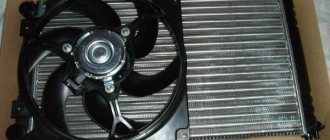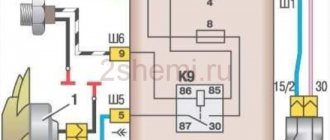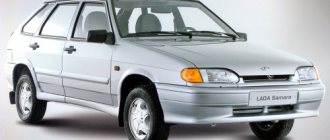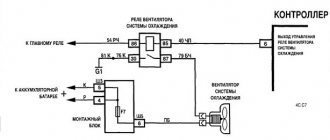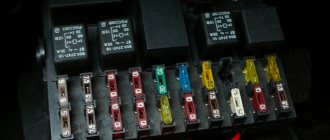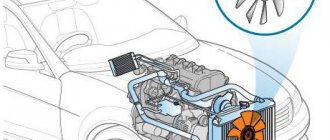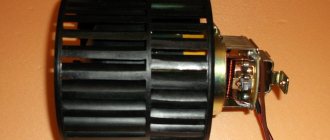Owners of popular Lada Kalina models often encounter situations when the cooling fan does not turn on. This situation forces the driver to periodically stop to allow the engine to cool down. If a malfunction occurs in frosty weather, then it has almost no effect on the functionality of the system, but in warm periods it significantly prevents the LADA Kalina from moving smoothly.
Most Lada Kalina owners are not able to independently diagnose the reasons why the cooling fan does not turn on, much less eliminate them. Tow trucks and services, as well as a switching diagram, are happy to come to their aid.
Reasons for fan failure
Here we indicate the most likely places in the cooling circuit, which you should take a closer look at if the cooling fan does not turn on.
- Thermostat. When the specified product fails, the fan also begins to make itself known through malfunctions and incorrect activation. To diagnose the thermostat, you will need to touch the outlet pipe (located at the bottom) of the LADA Kalina radiator on a warm engine. If this hose is warmed up, then the unit is normal; when it is cold, we determine that the thermostat is faulty. Since a part can break down quite often, it is recommended to carry a spare part with you. Replacement is not a difficult operation. To perform this, you will need to first drain the liquid from the circuit.
- Fuse and switching relay. These elements of the electrical circuit are also capable of frequent failure. Using the diagram of the location of the fuse links, we find the required fuse in the mounting block, remove it and check for burnout of the working “hair”. The block with these elements is located inside the cabin under the dashboard. To protect the fan circuit, an insert with a maximum current of 50 A is used. The fuse number is “3”.
The relay responsible for the operation of the node in question is listed as number “1”.
- Additional module for controlling fan functionality. To remove it, you will need to dismantle the air duct for supplying a warm air stream and, using the “10” key, unscrew the fasteners. Having taken out the block, we find a pair of switching relays responsible for the “command” to switch on and the maximum speed. Both elements can be diagnosed using a tester.
- Let's move on to the electrical switching of the fan. Using the same device, we check the wire lines of the node. If we find a break, we replace the wire with a new one with the same cross-section.
- Fan winding. Here the owner of the Lada Kalina feels despondent, since with such a malfunction, a replacement option is very likely, which is not cheap.
- Device activation sensor. If it is faulty, the fan will not activate, thereby causing the risk of overheating the power unit.
Air lock: features
"Kalina", like hundreds of other cars, is in no way protected from the appearance of an air lock. It cuts off the coolant supply. Solving this problem often involves some difficulties.
For a novice motorist who owns a Lada Kalina, an air lock is always a problem. To deal with it, you first need to remove the cap from the expansion tank. Then heat the engine to a temperature at which the gauge needle begins to reach the red zone. When the fan turns on, you need to press the accelerator pedal several times and turn off the ignition. Sometimes this is enough. The air lock completely disappears.
However, if the plug remains, more specific measures must be taken:
- The plastic screen is being dismantled;
- the clamp is released;
- the tube is removed from the fitting located on the throttle assembly;
- the expansion tank opens, its neck must be closed with a rag;
- Air is supplied to the open expansion tank until liquid begins to pour out of the tube. If it was not possible to break through the air plug in this way, you need to close the lid and return the removed tube to its place.
- then you need to warm up the engine again and turn off the ignition;
- remove the heating tube, but do not remove the cover. You need to wait a little until the liquid begins to pour out of the tube.
Since coolant is a toxic substance, this operation must be performed very carefully. Safety precautions require gloves.
During operation, you need to check the temperature of the tubes. The engine must be completely cool.
After draining the liquid, the tube is put on the fitting and tightened with clamps. Thus, the air from Kalina will be completely removed. This work can be done by any motorist; the help of a specialist is not needed. In order for Kalina to be free from such problems, it is necessary to constantly check the tightness of all connections and tighten the clamps.
How to replace a fan in Kalina?
The replacement process, if the cooling fan does not turn on, is quite a troublesome task, which is influenced by the tightness of free space for manipulation. So let's get started.
- 1. Here it is necessary to avoid the need to remove the radiator, which involves draining the fluid and takes more time.
- 2. Dismantle the housing of the filter element of the air intake system.
- 3. Remove the front grille.
- 4. Unscrew the fasteners of both head lighting devices.
- 5. We use a “10” head, through which we unscrew the fasteners of the upper front panel.
- 6. Now you need to disconnect the connectors that serve to connect the electrical fan module with the on-board network. We take the wires to the side to avoid interference.
- 7. The fan frame is secured with 4 bolts that need to be unscrewed.
- 8. We remove the fan with extreme care so as not to damage the nearby components of the engine compartment.
Installing the device involves performing manipulations using the reverse algorithm.
System diagnostics
If Kalina's fan does not turn on, first of all, you should start looking for the problem in the electric motor. To do this, disconnect the wiring, and then connect the device directly to the battery. This way you will know whether there is a problem with the fan, or whether you need to look for another reason for the faulty cooling system.
Next we check the contacts, relay and fuse. They should be found on the additional mounting block, which is located just to the right of the instrument panel. To check the fuse we use a tester. If this does not help solve the problem, look at the temperature sensor. Just warm up the engine, turn off the engine, and then turn off the sensor.
You can find it on the thermostat housing. After disconnecting the sensor, the fan will start in automatic mode. We start the engine. If it warms up and the Kalina cooling fan does not work, we begin to look for broken wiring.
Replacing relays and fuses
These protective and fan control components are fairly easy to replace. We remove the burnt element from the mounting socket and install a new analogue. It is convenient to use suitable tweezers here.
Steering rack Kalina
How to drain antifreeze from Kalina
Adjusting the Kalina generator belt
Main functional elements of the cooling system
Before you figure out why the Kalina engine cooling fan does not work, you should understand what the cooling system consists of in general. This may include:
- fan. The device is located on the radiator itself. When the antifreeze temperature reaches a certain value (on viburnum it is 95 degrees), the fan starts working, which speeds up the cooling process;
- temperature sensor. It sends a signal to start the fan when the motor temperature begins to rise;
- expansion tank. Antifreeze reacts very sharply to temperature fluctuations. When it contracts or expands, the expansion tank allows it to compensate for the change in fluid volume;
- water pump. Thanks to the pump, antifreeze circulates throughout the system;
- thermostat. The device is responsible for the process of supplying fluid to the radiator. It is this element that controls and maintains a stable temperature in the power unit.
A breakdown of any device leads to a situation where the cooling fan on the 8-valve Kalina does not work.
Next in the video is a solution to the problem when the cooling fan does not turn on in Kalina:
Improvements to the Kalina fan
In the Lada Kalina, the cooling circuit can be upgraded, which will significantly reduce the risk of forced shutdown due to the failure of one of the system components. The first step is to install a more reliable thermostat. Some LADA Kalina owners install a 6-hole unit and also supplement the circuit with a second stove valve and install another pump.
The second improvement option involves installing a “sports” version of the fan. This product is equipped with its own controller that can show the functioning of the system. Here you simply cannot do without making certain adjustments to the electrical circuit.
It would also be a good idea to install an additional button for forced activation of the fan. Most often it is located on the panel.
Album of electrical circuits of VAZ 1118
The VAZ 1118 operation and repair manual contains an album of all electrical circuits of the car. The general electrical equipment diagram of the Lada includes 59 elements: sources, consumers, protective elements, ECU (electronic control unit), sensors. Consumers of electricity in Lada are lamps (headlights, interior lighting, license plate, instrument panel, glove compartment), electric drive of the main vehicle options, switches and a sound signal.
A separate electrical diagram of the engine control system connections is shown with the designation of the main elements (spark plugs, injectors, ignition coil). The manual describes the front and rear wiring harness diagram, instrument panel wiring harness connection, door wiring harness connection, and air intake box wiring harness connection.
To ensure reliable contact of the wires, they are combined into terminal blocks. Each block has colored wires. The color in the diagram corresponds to the color of the wire on the car.
When reading an electrical diagram, you can determine by the number next to the wire which connector it is connected to. The designation 9/14 indicates that two wires are connected together and connected to the 9th block through the 14th connector.
Let's sum it up
If a cooling circuit fan in a Lada Kalina fails to operate, then such a malfunction can be corrected independently. We have reviewed almost the entire list of reasons that could cause a malfunction, and also provided an algorithm for replacing the unit. Use our material as instructions for action and tend to periodically inspect the cooling system; a switching diagram can also help you. This will minimize the risk of unpleasant circumstances occurring on the road.
When is it advisable to repair it yourself and in the service?
If your car has problems with the electric fan of the cooling system, you can fix the problem in the sequence described above. Almost any repair can be done by yourself. Since the main problems come down to faulty sensors, replacing them will not be difficult. It is enough to dismantle the faulty part and install a new one in its place. If the problem lies in bad contacts, then they can be cleaned or, as a last resort, the connectors can be replaced. If you are not confident in your abilities, then in order to avoid new problems it is better to contact the service.
Video: solving the problem of a constantly running fan
To decide whether to carry out independent repairs in case of problems with the cooling fan or seek outside help, you can familiarize yourself with the approximate prices for a particular operation.
Table: cost of repairing the cooling system with your own hands and in the service
| Name | Approximate cost, rub. | |
| On one's own | In service | |
| Replacing the Fan Sensor | from 150 | from 500 |
| Checking coolant leaks | for free | from 500 |
| Checking the coolant level | for free | from 500 |
| Replacing the cooling fan | from 500 | 500–1000 |
| Minor wiring repairs | for free | 200–500 |
| Radiator cleaning | for free | From 800 |
| Replacing the thermostat | from 350 | From 800 |
Constant rotation of the cooling fan on a cold engine is not normal. Therefore, you should deal with the malfunction that has arisen, find and eliminate the cause of its occurrence in order to prevent rapid wear of the device. Diagnostics consists of checking the coolant level, as well as the elements responsible for the operation of the electric fan, which every car owner can do.
Source
